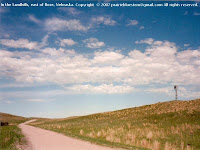Out in the hills, the Middle of Nowhere still exists

When I was growing up, we lived about eight miles from a wide-spot on the highway known as Rose, Nebraska (population 2.) Our house was about six miles off the highway and about 32 miles from the nearest real town.
People sometimes remark that I grew up in the middle of nowhere, but actually, there were quite a few neighbors in and around the Duff Valley where we lived. Our nearest neighbor lived about a mile and a half away. Our mailbox was only a mile from our house, where our land met the nearest county road.
The most sparsely-populated area of Rock County was east of where I lived. At that time (1950s and 1960s,) no improved road went through the hills from Rose on U.S. Highway 183 to Nebraska Highway 11, the road to Burwell. You could drive through, but when you came to the end of the maintained road, you had to open gates and follow some very rough and sandy two-track pasture roads. A four-wheel drive pickup truck was recommended.
Times have changed. Nowadays, there's a road all the way through from Highway 11 north of Burwell, Nebraska, to Highway 183 just north of Rose, Nebraska. Along the way, you pass the Sitz Ranch, the Gurney Ranch, and the Rose Church. It's a beautiful drive through Sandhills prairie that is still much as God made it. The road truly does go through the Middle of Nowhere.
I don't recommend the drive if you are a timid driver who is likely to get stuck in a sandy spot (can't slow down, must keep going or you're sunk!) You also need a clear understanding of where you're going and a good inner sense of direction (or a GPS unit.)
It was a great joy to drive my kids through this wild area of southeastern Rock County several times when we went on vacations to Nebraska. I think it gave them a better understanding of what the Sandhills are like and where their mother is from.
The photos in this post were taken along the road somewhere in the hills east of the Rose Church. In the image at the top of this post, the windmill is on top of the hill so it can catch enough wind to provide water for the cattle. The water tank is in the "pocket" down below, between the hills.
The image below is taken from the hill where the windmill stands. You can see the wind-sculpted peaks and pockets of the dune formations. Indeed, the Nebraska Sandhills are grassed-over sand dunes, the largest area of sand dunes in the Western Hemisphere.
One thing I should make clear -- this is not the only Middle of Nowhere. Many other remote, unspoiled, rural areas still exist in the United States -- and I'm glad that they do.


 I rarely remember my dreams more than a few seconds after I wake.
I rarely remember my dreams more than a few seconds after I wake.

















 Honestly, now -- have you ever
Honestly, now -- have you ever 





 Finding a perfect Christmas gift for someone I love.
Finding a perfect Christmas gift for someone I love.







